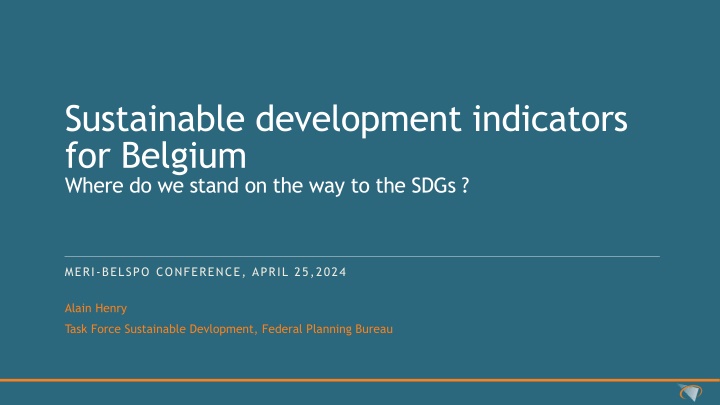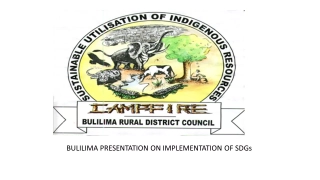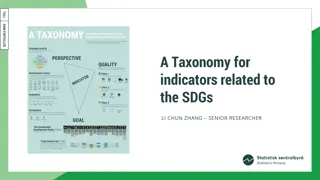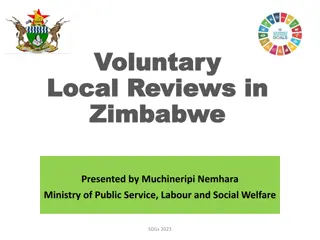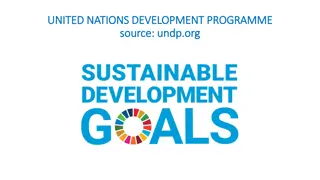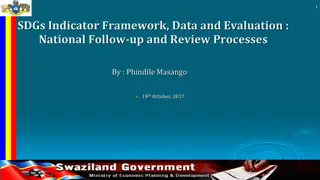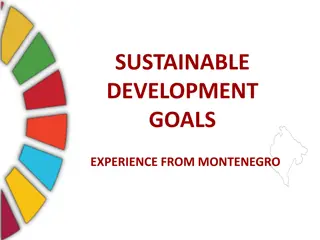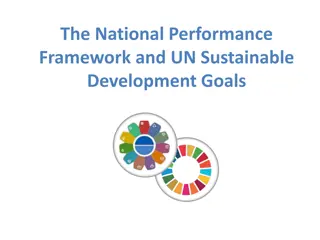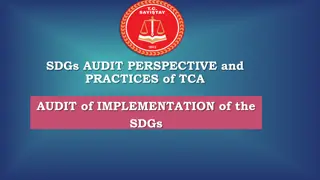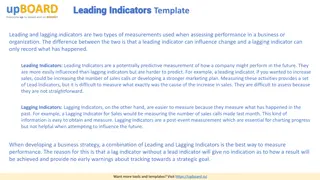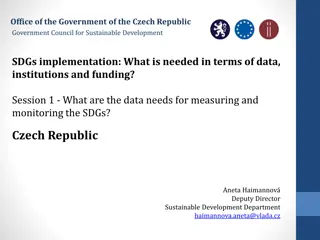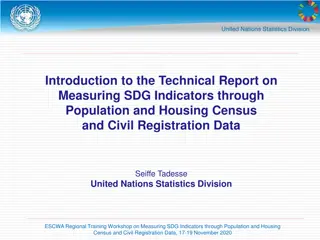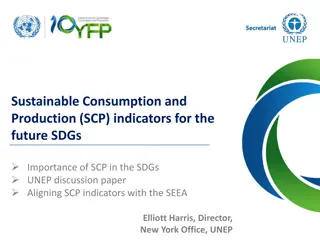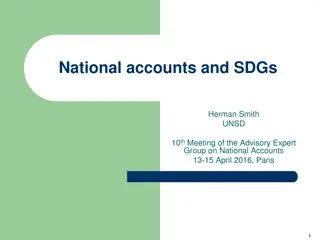Sustainable Development Indicators for Belgium: Progress Towards the SDGs
Belgium's progress on sustainable development indicators towards the Sustainable Development Goals (SDGs) is tracked through a set of global and national indicators. Key updates in the 2024 report include new indicators on child poverty and digital skills, along with revised definitions for capital stock and raw material consumption. The measurement of progress towards the SDGs includes indicators such as premature deaths due to chronic diseases, with an aim to reach targets by 2030.
Download Presentation

Please find below an Image/Link to download the presentation.
The content on the website is provided AS IS for your information and personal use only. It may not be sold, licensed, or shared on other websites without obtaining consent from the author.If you encounter any issues during the download, it is possible that the publisher has removed the file from their server.
You are allowed to download the files provided on this website for personal or commercial use, subject to the condition that they are used lawfully. All files are the property of their respective owners.
The content on the website is provided AS IS for your information and personal use only. It may not be sold, licensed, or shared on other websites without obtaining consent from the author.
E N D
Presentation Transcript
Sustainable development indicators for Belgium Where do we stand on the way to the SDGs ? MERI-BELSPO CONFERENCE, APRIL 25,2024 Alain Henry Task Force Sustainable Devlopment, Federal Planning Bureau
United Nations Sustainable Development Goals Transforming our world: the 2030 Agenda for Sustainable Development (UN, 2015) The Goals and targets will be followed up and reviewed using a set of global indicators. These will be complemented by indicators at the regional and national levels which will be developed by Member States (UN, 2015, 75) FPB activities on SDG indicators fall within the scope of - Interfederal Statistical Institute working group on SDG indicators - Institute for National Accounts Beyong GDP indicators 2
SDG indicators organisation & planning The Interfederal Statistical Institute (ISI) defined lists of SDG indicators for Belgium - Based on UN global indicators, Eurostat indicators and previous FPB works 2023: a set of 82 indicateurs - Published on www.indicators.be by the FPB - Used in the second National Voluntary Review (July 2023, UN HLPF) Q1 2023: lists of indicators at the heart of a debate with federal administrations and Advisory Councils - Starting from the 82 indicators: 10 to remove, 12 new, 4 to redefine - Plus 23 indicators to be developped by relevant administrations, with 9 priority indicators 2024: 78 indicators (2 new, 6 removed, 2 redefined) 2025: 84 indicators 3
Changes in the 2024 report New indicators - Child poverty (i02) - Digital skills (i25) New definitions - Capital stock (i45) / Physical capital stock - Raw material consumption (i55) / Domestic material consumption Removed indicators - Life expectancy included in Healthy life years (i12) - Depression included in Mental disorders (i17) - Household consumption (no objective) - Gross investment in the physical capital stock (no objective) - Knowledge capital stock included in Capital stock (i45) - Net external position (no objective) 4
How to measure progress towards the SDG? 160 Using indicators Premature deaths due to chronic diseases 140 Extrapolation of current trends: does it reach the target in 2030? Using existing BAU scenarios (FPB, NECP, ) Or extrapolating a trend ? 120 100 ? 80 SDG 60 ? 40 If no target, does it goes in the right direction (over 2000-2022 period)? 20 0 2003 2006 2009 2012 2015 2018 2021 2024 2027 2030 5
indicators.be Sustainable Development Indicators indicators.be // annual update Detailed information on indicators i01 - i78 data = charts & data tables, from 1990 onwards description = definitions, objectives, breakdowns (more in NL & FR) download of text and data per indicator links to UN SDG, sources, institutions assessment = assessing trends towards objectives 6
SDG in Belgium 51 progress indicators COMPONENT TOTAL ASSESSMENT SOCIAL ENVIRONMENTAL ECONOMIC GOVERNANCE FAVOURABLE 2 4 1 0 7 UNDETERMINED 10 4 3 2 19 WITH A TARGET UNFAVOURABLE 0 0 0 0 0 FAVOURABLE 4 4 0 1 9 DESIRED DIRECTION (NO TARGET) UNDETERMINED 0 1 1 0 2 UNFAVOURABLE 7 3 2 2 14 Based on available date on octobre 31, 2023 7
Changes between February 2023 / February 2024 New target (strat gie interf d rale pour une g n ration sans tabac) Smokers i21 de Exposure to particulate matter i52 Strenghtened target, from 10 to 5 g/m (OMS) de New target (2030 Objectives from COP Biodiversity 2022) Natura 2000 protected land area i66 de New indicators (replaces Domestic material consumption) Raw materials consumption i55 de Target 2020-30 is already exceeded (number of people affected by 2021 floodings) Victims of natural hazards i61 de Forests with FSC or PEFC label i67 Indicator decreased in the last 2 years de 8
Belgium in the EU ranking for latest year Overview of most recent year in 68 charts BE compared to EU countries, EU average and 3 neighbours (DE, FR, NL) Average results | example: 59 indicators compared to other EU countries (in 3 groups) BE 22 times 23 14 in top third middle third bottom third example: Natura 2000 protected marine area (i65) Underachievement in reading (i26) Employment rate (i40) 9
Belgium in the EU per SD component Number of indicators (total = 59) | most recent year COMPONENT ENVIRON- MENTAL 2 5 7 14 TOTAL BE COMPARED TO EU SOCIAL ECONOMIC GOVERNANCE TOP THIRD MIDDLE THIRD BOTTOM THIRD 13 15 4 3 4 3 0 0 3 22 23 14 59 3 TOTAL 31 11 Do not confuse international comparison & trend assessment towards SDG ! BE scores better BE scores worse 10
42 indicators broken down by Region Overview in 42 charts: BE and three regions, 2015-2022 - Descriptive approach Ranking of regions very stable over 2015-2022 - 26 indicators with no changes in ranking - 4 indicators with only 1 year of data - 7 indicators with one change for only one year - 5 indicators with more changes in the ranking Evolution of regions over 2015-2022 - 18 indicators: all regions move in the desired direction (towards the objective) - 5 indicators: all regions move in the undesired direction - 14 indicators: various directions - 5 indicators: without changes 11
Breakdown across various categories of population "Leave No One Behind" = "we wish to see the Goals and targets met for all nations and peoples and for all segments of society. And we will endeavour to reach the furthest behind first." (2030 Agenda, 4) Women / men (38 indicators) No difference: Life Satisfaction (i20) and Dwellings without adequate heating (i34) Worst situation: 19 for women and 17 for men Biggest differences against women: Postponement or cancellation of health care for financial reasons (i07) and Security feeling in public spaces (i73) Biggest differences against men: Road deaths (i20) and Fatal accidents at work (i42) Other breakdowns: age (16), income (20), education (11), household type (6), 12
Many differences are stable over time, except Guaranteed minimum income beneficiaries (i05): share of beneficiaries aged 18-24 has more than doubled Mental disorders (i17): differences by income level have increased Higher education graduates (i24): share of men (25-34 years old) increases more slowly than the share of women Long-term work incapacity (i38): rapid increase for - people between 50 and 64 - women 13
Conclusions Cooperation with all Belgian actors With unchanged policies, few SDGs would be reached in 2030 Need of more quantitative objectives for a more accurate assessment of the trends towards the SDGs Useful to zoom on specific categories of population 14
Thank you More information www.plan.be www.indicators.be Questions Patricia Delbaere dp@plan.be Alain Henry ah@plan.be 15
Sustainable development indicators for Belgium Where do we stand on the way to the SDG s ? MERI-BELSPO CONFERENCE, APRIL 25,2024 Alain Henry Task Force Sustainable Devlopment, Federal Planning Bureau
